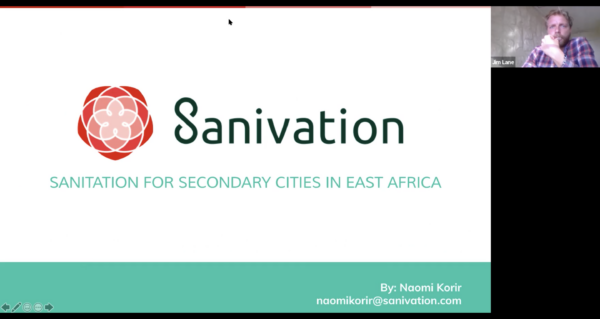In collaboration with EWB-NCSU, the Global WaSH Student Chapter hosted Jim Lane and Naomi Korir from Sanivation on February 2nd, 2021. Sanivation is a Kenyan based sanitation company that’s pushing the boundaries in waste management and sanitation solutions. They presented an overview of Sanivation, their goals, and a detailed look at their research strategies and current knowledge gaps.
Sanivation was founded in 2014 and headquartered in Naivasha, Kenya. Sanivation’s mission is to provide cost-effective sanitation services to help realize sustainability in urbanizing communities. Sanivation’s recently contracted Stantec design firm to create design drawings for a city-wide treatment plant in Naivasha that will treat waste for 80,000+ individuals and produce 1,200 tons of fuel monthly. Sanivation aims to replicate this city-wide treatment plant in 10 cities in the next 10 years, serving more than 3 million people.
The problem in East Africa is that only 10% of the waste is safely treated and that the existing services are too expensive. There is a greatest need in secondary cities because people are moving to these cities more than to megacities. Therefore, secondary cities are having the most issue with sanitation which causes significant environmental pollution and public health. Sanivation is addressing this issue by recognizing that waste has value and that it is possible to partner with local governments to increase sanitation services. Their plants treat and convert waste into biomass fuel.

Jim Lane presenting about Sanivation
Sanivation presented 5 main research goals: assumption validation, impact investigation, supporting Sanivation’s functional areas, new products research and development, and fecal sludge treatment process innovation, monitoring and evaluation. The, they presented their research gaps where students can participate and work with them to fill these gaps.
The first gap deals with ways of quantifying their impact and how are these solution benefiting minorities. The second one is about renewable energy and sharing facts and figures to customers about the benefits of using their Superlogs, a more cost and energy-efficient fuel alternative that replaces firewood in biomass boilers, over traditional firewood. The third gap is about by what percentage they can increase the safely managed sanitation and still maintain a minimum cost. The fourth gap deals with solid waste management and what are innovative ways to manage and finance solid waste. Could we mix solid waste with human waste to make products? The fifth gap deals with emerging markets and other alternatives for revenue from feces. The sixth gap is about designing new fecal sludge treatment plants for different needs and contexts with the latest trends in sanitation technologies. The seventh gap deals with the market analysis for biomass fuel and evidence of this resource. Is there a market for this in South America? Finally, for the last gap involves using circular economy to improve a city’s sustainability.
As closure for the presentation, Sanivation added some of the benefits students get for working with them which include access to funding project resources such as lab equipment and materials, access to research fellow accommodation, and working along with the research team!